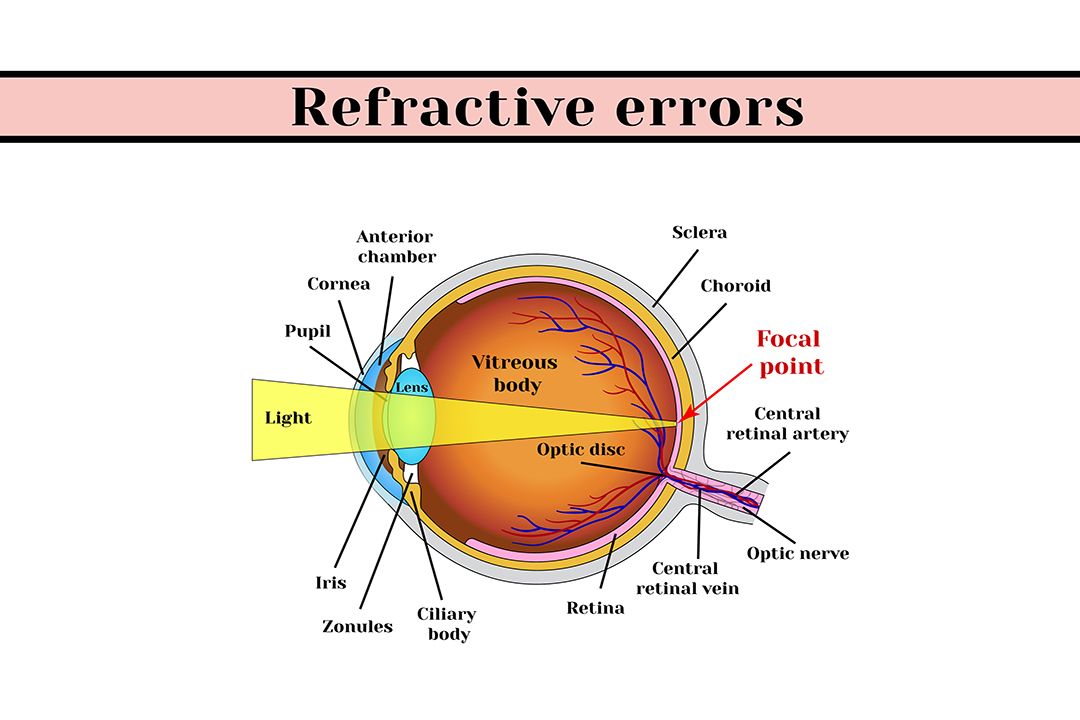Kelainan Refraksi Mata
Bagaimana Mata Memfokuskan Cahaya?
Agar kita dapat melihat dengan jelas, sinar cahaya dari suatu objek harus difokuskan tepat pada bagian belakang dalam bola mata, yaitu retina.
Mata bekerja seperti kamera:
- Memiliki bukaan di bagian depan (pupil)
- Lensa pemfokus di bagian tengah (lensa kristalin)
- Bagian penerima cahaya di bagian belakang (retina)
Jika sinar cahaya tidak terfokus tepat di retina, maka terjadi kelainan refraksi.
Jenis Kelainan Refraksi
Kelainan refraksi yang umum meliputi:
- Miopia (rabun jauh)
- Hipermetropia (rabun dekat)
- Astigmatisme (silinder)
Miopia (Rabun Jauh)
Miopia terjadi saat sinar cahaya jatuh di depan retina, biasanya karena bola mata terlalu panjang atau daya fokus lensa terlalu kuat.
Akibatnya, objek yang jauh tampak buram, dan akan terlihat lebih jelas saat berada dekat dengan mata.
Miopia dapat:
- Diturunkan secara genetik
- Berkaitan dengan kelahiran prematur
- Terjadi pada usia berapa pun
Kacamata digunakan untuk membantu memfokuskan cahaya tepat ke retina sehingga penglihatan menjadi lebih jelas.
Miopia biasanya bertambah setiap tahun, dan menetap (stabil) pada usia akhir remaja hingga awal 20-an.
Saat ini belum ada pengobatan yang secara luas diterima untuk menghentikan progresi miopia.
Alternatif lain:
- Lensa kontak, jika pasien mampu merawatnya secara mandiri
- Operasi laser dapat dipertimbangkan pada usia minimal 18 tahun, dengan syarat ukuran miopia sudah stabil
Hipermetropia (Rabun Dekat)
Hipermetropia terjadi saat sinar cahaya jatuh di belakang retina, biasanya karena bola mata terlalu pendek atau daya fokus mata terlalu lemah.
Hal ini menyebabkan objek dekat maupun jauh tampak buram.
Pada anak-anak, sedikit hipermetropia adalah kondisi yang normal, dan biasanya tidak memerlukan koreksi, karena mata anak masih bisa mengkompensasi melalui mekanisme akomodasi alami.
Namun, jika hipermetropia cukup besar atau menyebabkan mata juling ke dalam (esotropia akomodatif), maka diperlukan kacamata koreksi.
Perkembangan hipermetropia:
- Umumnya meningkat di awal masa kanak-kanak
- Mulai menurun pada usia praremaja hingga remaja awal
Alternatif selain kacamata:
- Lensa kontak
- Operasi laser, bila usia dan kondisi mata sudah sesuai

Astigmatisme
Astigmatisme terjadi ketika cahaya yang masuk ke mata terdistorsi karena kornea melengkung lebih kuat ke satu arah dibanding arah lainnya. Bentuk mata penderita astigmatisme lebih menyerupai bola sepak (oval) dibanding bola basket (bulat). Akibatnya, cahaya tidak difokuskan di satu titik, melainkan di beberapa titik (di depan dan/atau di belakang retina). Hal ini menyebabkan penglihatan dekat dan jauh menjadi kabur.
Kacamata biasanya diresepkan untuk astigmatisme yang signifikan. Lensa kontak dan operasi laser dapat menjadi alternatif kacamata pada usia yang sesuai.
Bagaimana mata memfokuskan cahaya?
Agar dapat melihat dengan jelas, cahaya dari objek harus difokuskan ke lapisan bagian belakang dalam mata, yaitu retina. Mata bekerja seperti kamera—memiliki bukaan di bagian depan (pupil), lensa untuk memfokuskan (lensa kristalin), dan bagian penerima cahaya di belakang (retina). Jika cahaya tidak difokuskan tepat di retina, maka terdapat gangguan refraksi (kelainan pembiasan).
Jenis-jenis gangguan refraksi meliputi: miopia, hiperopia, dan astigmatisme.
Miopia (rabun jauh)
Miopia terjadi ketika cahaya difokuskan di depan retina karena bola mata terlalu panjang atau daya fokus terlalu kuat. Objek yang jauh tampak buram, tetapi menjadi lebih jelas saat mendekat. Kondisi ini dapat diturunkan secara genetik atau dikaitkan dengan kelahiran prematur, dan dapat muncul di usia berapa pun.
Kacamata membantu memfokuskan cahaya pada retina dan memperbaiki penglihatan. Miopia biasanya memburuk setiap tahun dan cenderung stabil saat usia akhir remaja hingga awal 20-an. Saat ini belum ada pengobatan yang secara luas diterima untuk menghentikan progresi miopia.
Bagi yang sudah mampu merawat dirinya secara mandiri, lensa kontak bisa digunakan sebagai pengganti kacamata. Setelah usia 18 tahun dan jika gangguan refraksinya sudah stabil, operasi laser dapat menjadi pilihan.
Hipermetropia (rabun dekat)
Hipermetropia terjadi ketika cahaya difokuskan di belakang retina, biasanya karena bola mata terlalu pendek atau daya fokus terlalu lemah. Hal ini menyebabkan penglihatan dekat dan jauh menjadi buram.
Sejumlah kecil hipermetropia merupakan hal yang normal pada masa kanak-kanak dan biasanya tidak memerlukan koreksi. Anak-anak umumnya mampu mengatasi hal ini dengan mekanisme fokus alami mata mereka (akomodasi).
Namun, jika hipermetropia cukup besar, mungkin diperlukan koreksi dengan kacamata, terutama jika disertai mata juling (esotropia akomodatif). Hipermetropia biasanya meningkat di masa kanak-kanak awal dan menurun saat pra-remaja hingga awal masa remaja. Lensa kontak dan operasi laser dapat menjadi alternatif kacamata pada usia yang sesuai.

Astigmatisme
Astigmatisme terjadi ketika cahaya yang masuk ke mata mengalami distorsi karena bentuk kornea lebih melengkung ke satu arah dibandingkan arah lainnya. Bentuk mata pada astigmatisme lebih menyerupai bola sepak (oval) daripada bola basket (bulat sempurna). Akibatnya, cahaya difokuskan di beberapa titik (di depan dan/atau di belakang retina), bukan di satu titik yang jelas.
Kondisi ini memengaruhi penglihatan dekat maupun jauh.
Kacamata biasanya diresepkan untuk astigmatisme yang signifikan. Lensa kontak dan operasi laser bisa menjadi alternatif pada usia yang sesuai.



 ENG
ENG